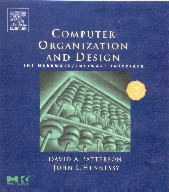 |
| (Textbook. Click for information.) |
Computer Organization II
Fall 2004
Recitation 10
Pipelining: Forwarding
Week 10: Oct 25-29
Due (on time): 2004-11-03 23:59:59
Due (late): 2004-11-07 23:59:59
Recitation 10 must be submitted
following directions at: submissions on or before
|
Outline: This recitation studies the pipelined implementation of MIPS. In particular this part looks at the forwarding necessitated by data hazards. You are to turn in a annotated diagrams showing the flow of data and control signals under the circumstances made specific below. In summary you will be working on Exercises 6.15 and 6.16 on the CD under the For More Practice portions. This material is confusing in the way it is displayed, you I will be explaining it carefully below.
lw $10, 20($1) sub $11, $2, $3 and $12, $4, $5 or $13, $6, $7 add $14, $8, $9
On the CD, Figure 6.14.5 (Cycles 1 and 2), Figure 6.14.6 (Cycles 3 and 4), Figure 6.14.7 (Cycles 5 and 6), Figure 6.14.8 (Cycles 7 and 8), and Figure 6.14.9 (Cycle 9), give diagrams for successive cycles.
As the first part of this recitation, you are to use a xerox of the blank diagram given in Figure 6.14.10 on page 6.14-12. (GIF image of this figure: F6.14.10.gif.) You should fill in this diagram with 9 cycles of the following sequence:
lw $10, 20($1) sub $11, $2, $3 and $12, $4, $5 lw $13, 24($1) add $14, $5, $6
The first three cycles are the same as on the CD (since the first three instructions are the same), you only need diagrams for Cycles 4 through 9. (Note that a fair amount of these cycles will also be the same as in the text.)
sub $2, $1, $3 and $4, $2, $5 or $4, $4, $2 add $9, $4, $2
On the CD are diagrams of the pipelined implementation, with emphasis on the forwarding unit. The course of executing these four instructions, including the forwarding, is shown in Figure 6.14.11 (Cycles 3 and 4), and Figure 6.14.12 (Cycles 5 and 6). This exercise asks you to trace through the following three instructions in a similar way:
add $1, $1, $3 add $4, $2, $1 and $5, $4, $1
You are to use a xerox or printout of Figure 6.14.13, and trace Cycles 3, 4 and 5. (Here is a GIF image of a figure you can use for this part: F6.40.gif (from the 2nd ed). The actual Figure 6.14.13: F6.14.13.gif is the wrong diagram, since it is the same as Figure 6.14.17.) You should pay particular attention to the forwarding unit.
|
Contents of submission
for Recitation 10: Last Name, First Name; Course Number; Recitation Number (10).
|